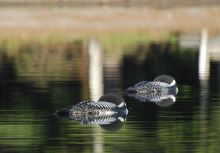How Do Loons Sleep?
Due to the extreme rear placement of their legs on their bodies, loons are slow, clumsy, and therefore vulnerable when they are on land. Because of this, they only come up on land when it is absolutely necessary, such as when they are nesting or when they are injured or ill. The rest of their time is spent on the water—including when they sleep! How, when, and where do loons sleep?
The Loon & Diver Stewardship Working Group of which Journey North is an active member has created this informative fact sheet to be distributed widely by individuals and organizations interested in loon conservation and protection. Please help Journey North spread these important messages.
Download the Loon Fact Sheet in either English or French. (Spanish translated fact sheet coming soon.)
Egg Shell and Membrane Removal
After the hatch of their first chick, it is very common for adult loons to remove the membrane from the first hatched egg and any attached large pieces of eggshell from their nest. This behavior has been widely documented here in New Hampshire, both on LPC's Live Loon Cams (see video below) and by wildlife photographers, as well as by biologists in the field. Why do loons remove shells and membranes from their nests when many other bird species do not perform this behavior?






